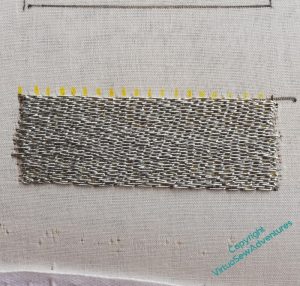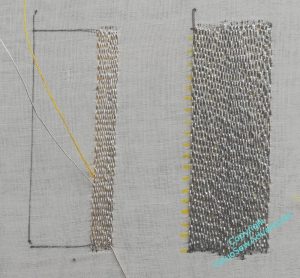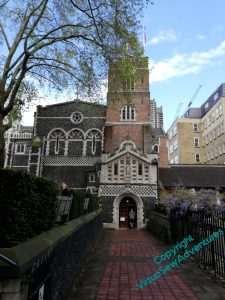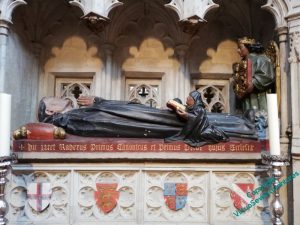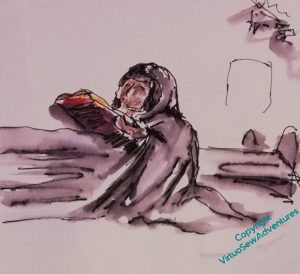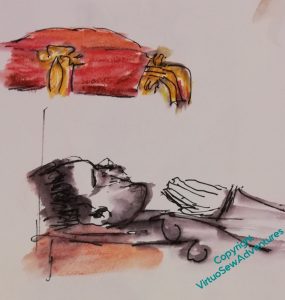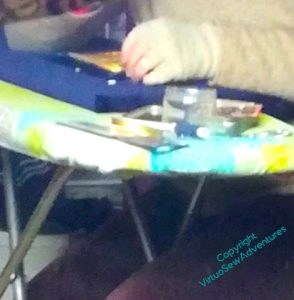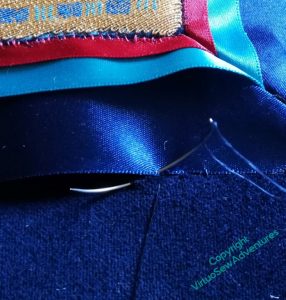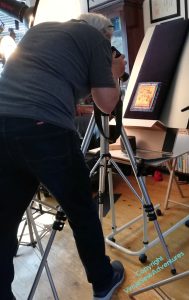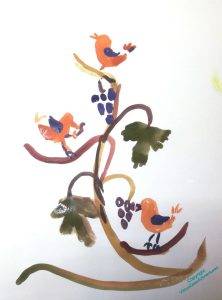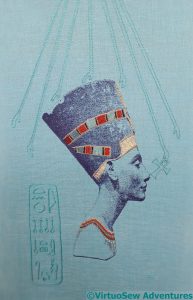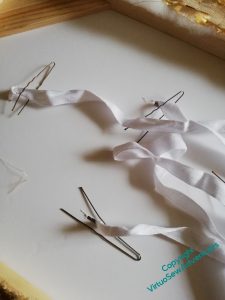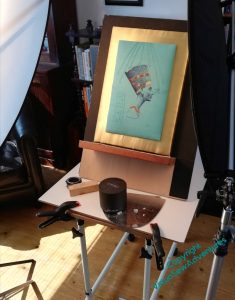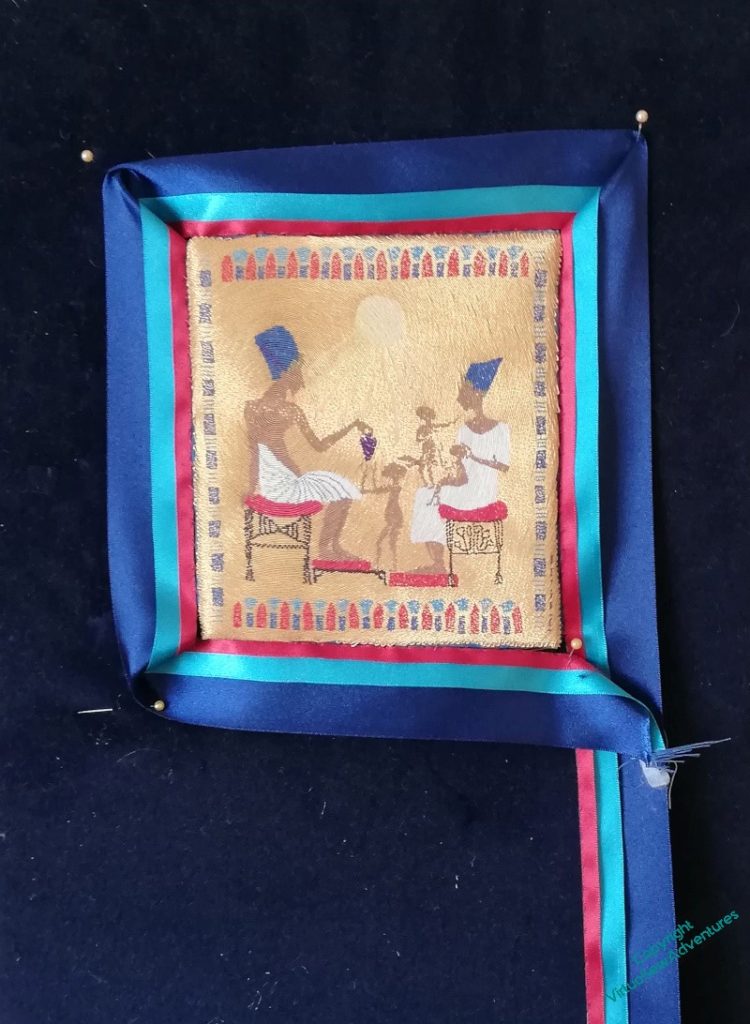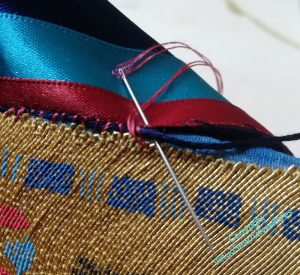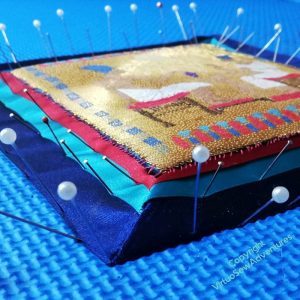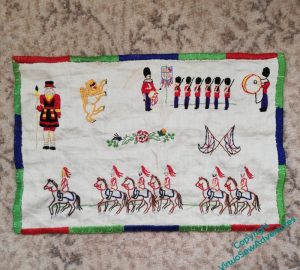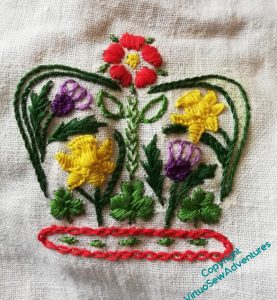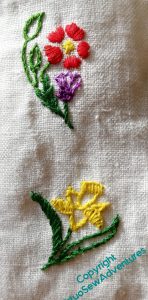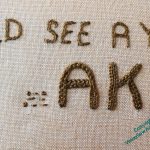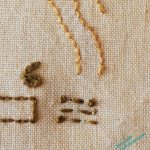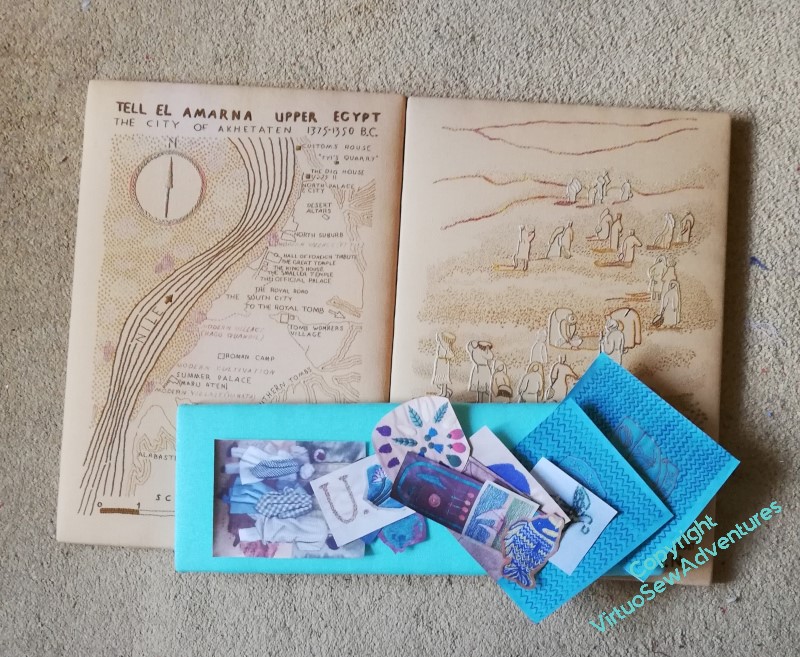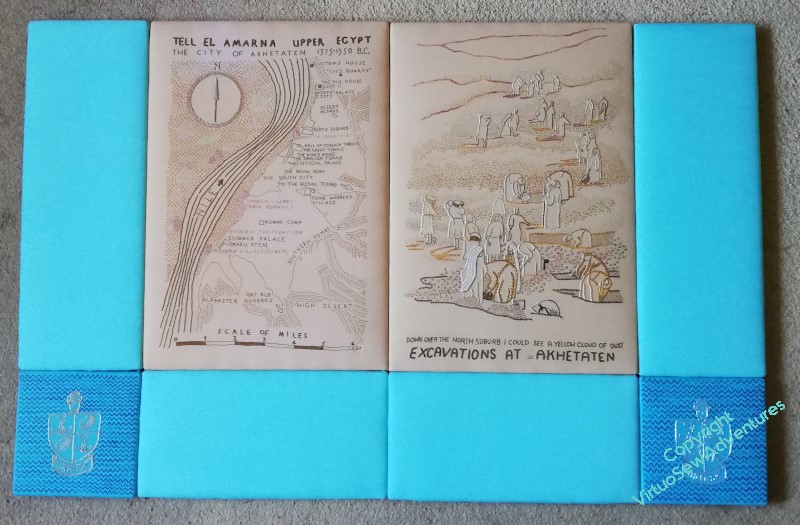About Rachel
View all posts by Rachel
Another decision to make!
Underside couching, I’ve decided, is rather like satin stitch. In concept it is simple, not to say obvious. The execution, accurately and aesthetically, is very much less so!
I had intended to use the gold thread left over from the Amarna Family Group as my thread for William’s background, in the interests of economy, if nothing else, but then I had advice from Tanya Bentham and others, to at least try the Smooth Passing, which might for a multitude of reasons behave rather better.
So here you see the second practice block started, again using silver, but this time smooth passing thread.
The passing thread is, as suggested, much pleasanter to use, and creates a smoother and less shadowed surface, which in turn, I think, should help the pattern I intend to use. Which, you may note, I’ve not yet got around to practicing!
However, that brings me to my decision. I do not think that I can be certain that the spool of Gold Smooth Passing I have left over from a Thistle Threads project will finish the job, so I shall have to buy some smooth passing. And it turns out that Gold comes in more than one shade!
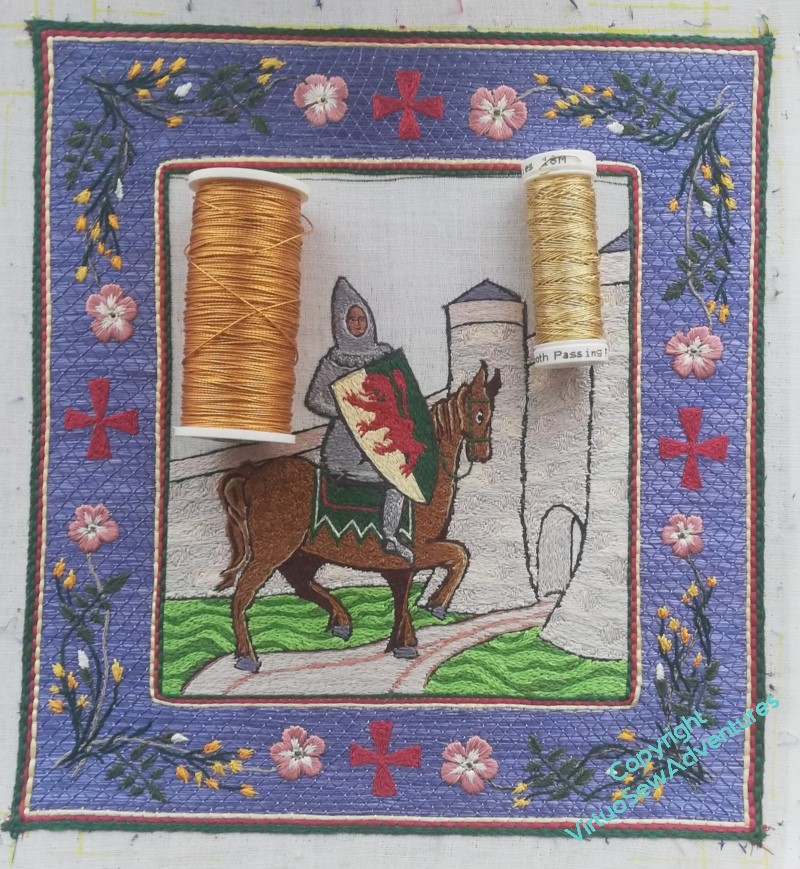
The decisions are never at an end, are they…
And since I’m working on pulling the Amarna pieces together properly at present, I can’t claim to be giving my whole mind to the decision-making!
More layouts..
Telling stories without words can be a little tricky..
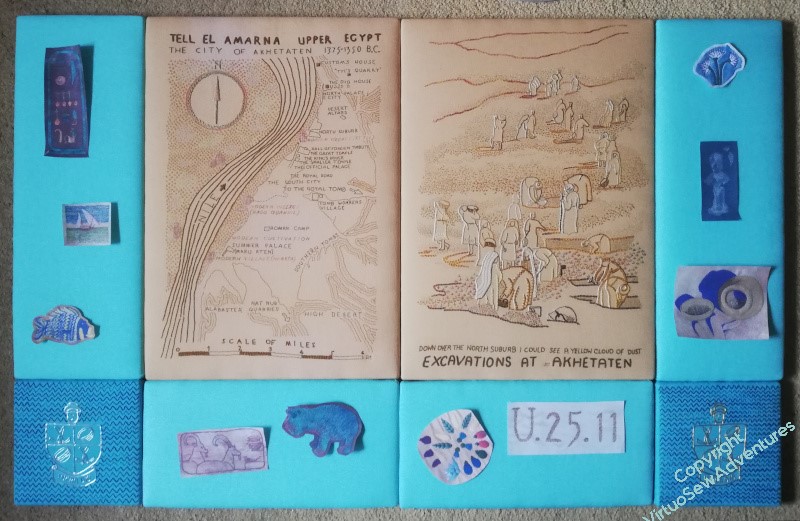
I’ve managed to get the Amulet and the Crock together here, and “Typed on Camelback” is on the horizontal panel, which works. But I put the Lotus Fragment at the top because it is the first thing mentioned in the book, only to find that it makes the whole thing fizzle out rather.
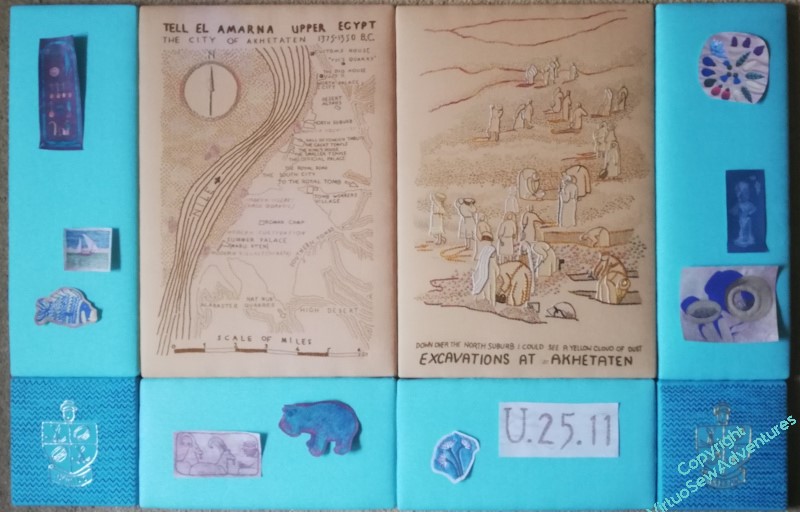
So for the next one, I’ve swapped the Faience Necklace with the Lotus Fragment. Better, I think. I like the way the Amulet echoes the Cartouche in shape, but not in placement. I also rather like the new, closer placement of the Fishie with the Felucca. Typed on Camelback and the Lotus Fragment look fairly happy together, too.
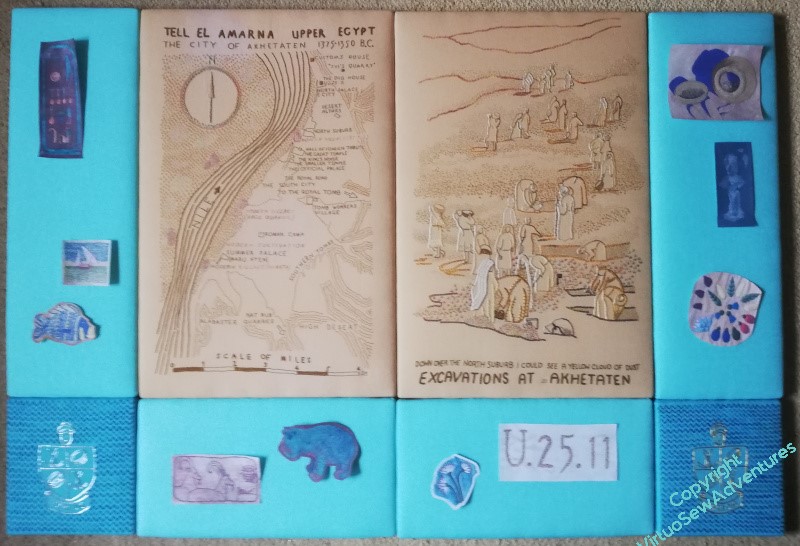
So, final tweak. The square tops of the Cartouche and the Crock of Gold balance each other nicely, and the grouping of Fishie and Felucca take only a little more space than the Faience Necklace. I think I will put the Hippo lower and the Antelope higher, mirroring the Lotus Fragment and Typed on Camelback. And incidentally, making more sense of them – antelope are dry land animals and hippos like water, after all!
So, have I finally made sense of this?
You know, I think I may have done!
Researching Rahere
A journey through London gave me the opportunity to visit the Church of St Bartholomew The Great in Smithfield, which is indeed very close to the Hospital Rahere founded, known today as St Barts.
It, and Rahere himself, have had varying fortunes and visibility over the years, and, for example, Rahere’s tomb was built in the fifteenth century, nearly four centuries after his death.
I haven’t yet discovered whose shields are displayed there, but it seems likely I will. The Rector was involved in a wedding rehearsal when I arrived, but I carried on quietly sketching and walking around the Church, staying out of the way as best I could while still continuing to work.
And I had my reward in due course, when, on the principle that Bairns As Don’t Ask, Don’t Get, I tracked him down afterwards and asked what, if any, information they had on Rahere and the early days of his foundation.
I may have bewildered him slightly – I have the impression that’s not the first thing people usually say! – but he took it well, and informed me that as this year is the anniversary of the foundation, a substantial History has been produced. So when that arrives, I shall have more to say on the subject, I’m sure!
Laying out the “spots”
The first place to start with planning layouts was to simply trim my photocopies neat, square, and not too close, and see what result I could achieve.
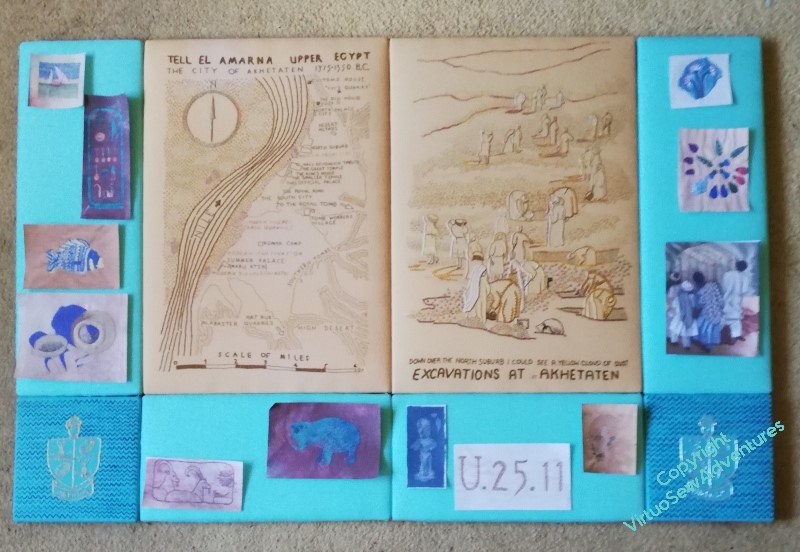
I’m not at all pleased with this. It looks much too congested – or alternatively, not congested enough! If I had twice as many spots, maybe slightly smaller, and had them all jammed together, it might work, but this is betwixt and between, which is no place to be!
So I tried again, trimming some of the pieces closer or in a more shaped fashion, but still all of them being used. This is better. Actually, much better – but I think it still feels congested, and rather unbalanced. So, I need to think about what I can pick up from this, and take forward.
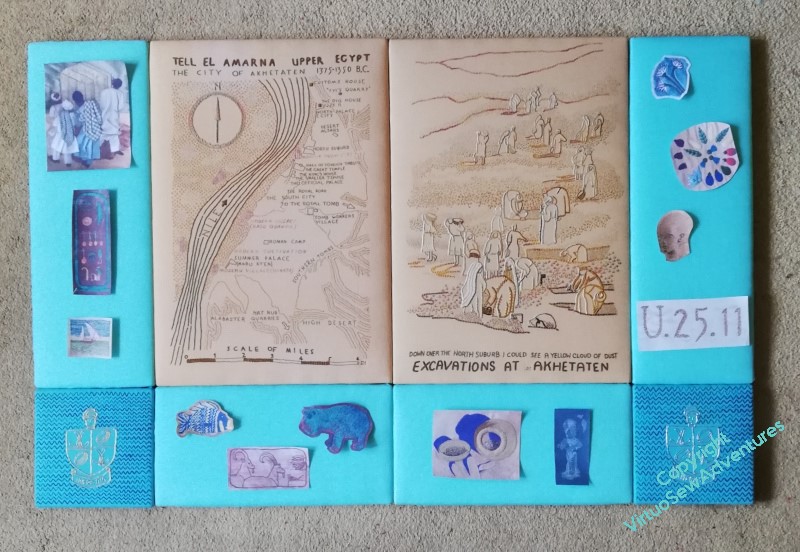
But before I do that, I do have a guideline in mind already: I want to use the “spots” which refer to finds or incidents that Mary referred to in the book with the View, and the ones which depict things already known about with the Map. So it’s arguable that I should either have “Loading The Felucca” with the View, or mount it separately. As it is bordering on too large in any case, I think I may choose to mount it separately.
The other one which is a bit tricky to wrangle is “Typed on Camelback”. It clearly has to be with the View, but it’s a little too wide to fit comfortably on the uprights, where I had it in the earlier two pictures.
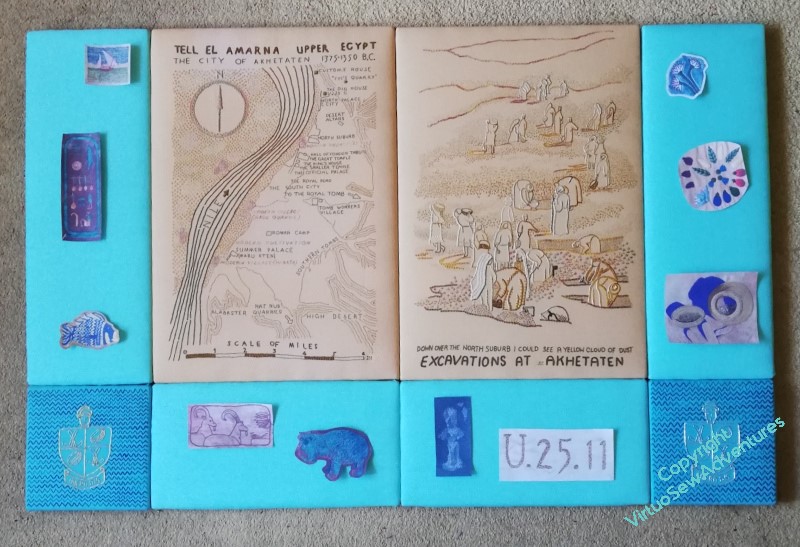
So how about this? I’ve taken off “Loading the Felucca”, and the “Head of Ankhsenspaaten”, and everything is now rather more spaced out. I think this works quite nicely, but at the same time, I thought the “Hittite Amulet” and the “Crock of Gold Hoard” had looked very happy side by side, so I wonder what further adjustment I can come up with?
Finishing The Family
The next challenge was to work out how to attach the Family to the navy blue velvet stele I had prepared for them. It was a bit too awkwardly sized for the various tables I have tried to work on – or they were at entirely the wrong height – so I ended up perched on a stool beside the ironing board.
What’s the phrase? Adapt, improvise, and overcome!
I keep trying to make use of my Grandmama’s curved needles. For some reason it has become one of those skills I am determined to master. Goodness, I wish I’d asked Grandmama how she managed!
In this case, I began to feel that maybe I was getting the hang of the idea. Gradually. Work speeded up a little after I managed to remove a burr from the point, restoring the proper sharpness.
I was a bit baffled to begin with as to how to remove that burr, but a question on Mastodon elicited several replies in varying detail. I used a nail file, since you ask (lowest tech solution), although one of my friends suggested a dart sharpener – which I never even knew was a thing that existed!
I have a lot of mounting embroidery in my future, so I suppose I am going to get the hang of it – or go stark crazy, of course, always an option!
Anyway, several stitching sessions later – the Family had to stand on their heads for their closeups, to bring themselves into reasonable range of the camera!
Stella’s Birds – more thinking about the design
You may recall that I said last time I mentioned the design I am trying to work out here, that it was proving very difficult to balance three birds not looking the same way, and that making them look the same way didn’t work at all.
Then it occurred to me that – obviously! – the two earlier birds would be facing towards the one that’s singing. Partly because we always turn to look where the noise is coming from, and partly because that is their aspiration.
You will notice that all of the rough designs I’m playing with here are in colour, which is not at all in keeping with my idea of using Mountmellick work. That’s because at present I want to find it easy to distinguish parts of the design. When I’m a little clearer about the shapes and their flow, I’ll start moving towards a more tonal patterning that will help me to think about stitch choice.
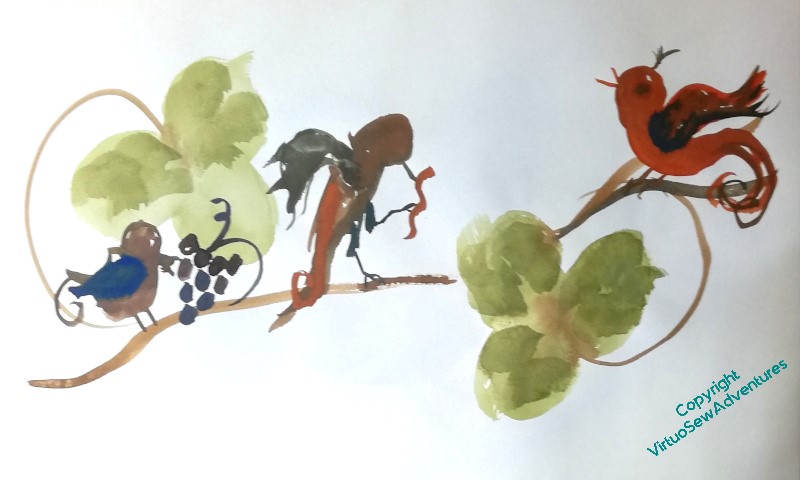
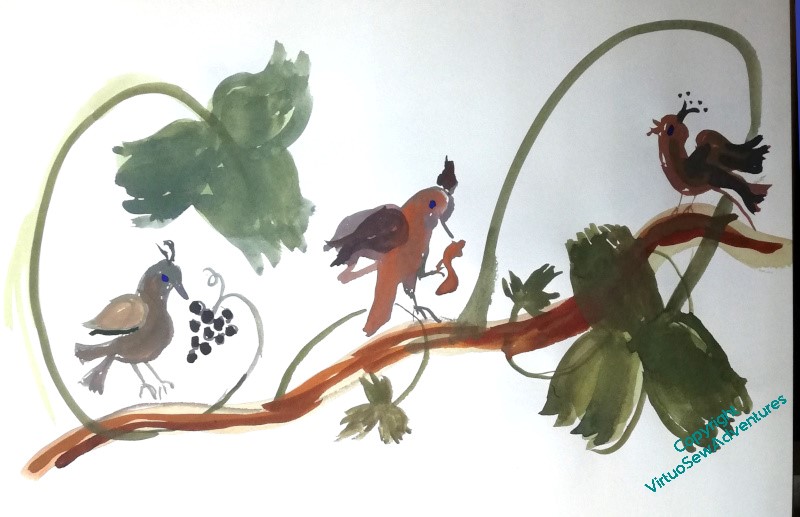
In the meantime, I am playing with shapes and layout in very vague terms.
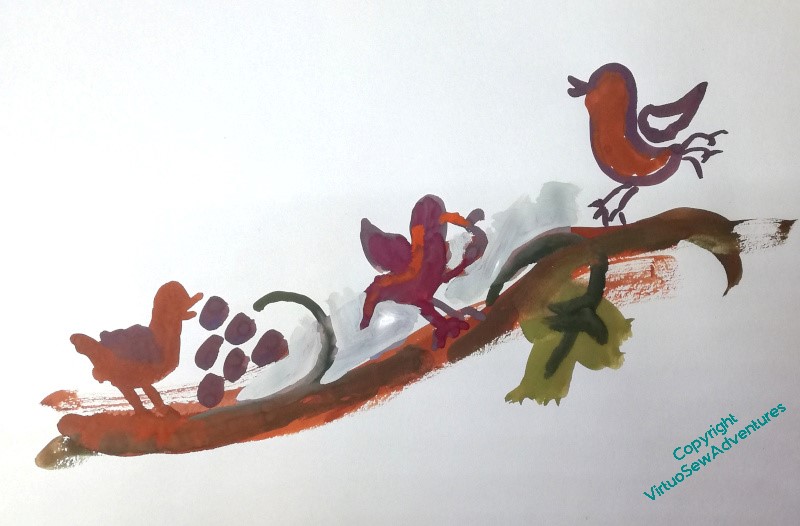
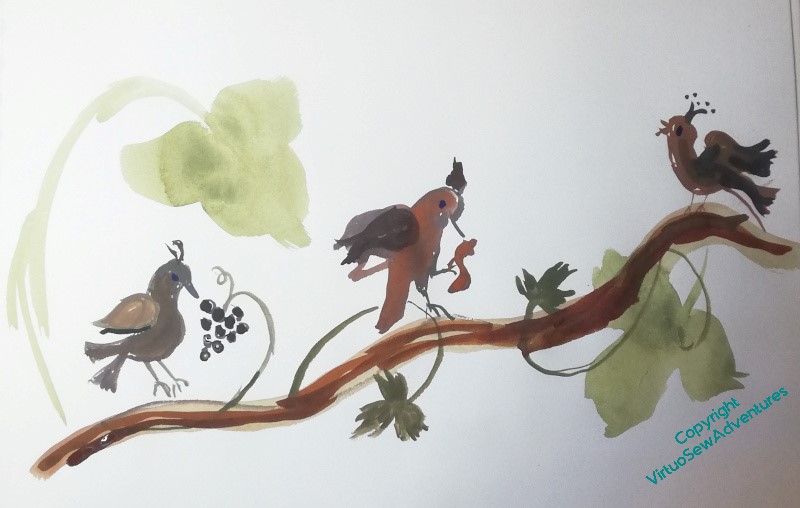
Eventually, I want the birds to be quite medieval and slightly mad in appearance, and I’m thinking of trying to find some suitable thread – a round, matte cotton in two or three thicknesses – in a variegated colour that will help me to create the look of carved wood. The challenge is in finding it. This is not something easily bought online with any confidence, and so many of the thread companies don’t go to the shows anymore.
Mounting the Head of Nefertiti
As regular readers are well aware, when in doubt I have a policy of benign neglect which allows ideas to ebb and flow until something filters to the surface as The Right Idea. Sometimes this takes longer than others, although I have noticed that recently I’m getting ideas a bit more quickly.
Or maybe it’s just everything coming to a head, all at once!
Nefertiti came off her frame after I’d finished her (in 2017, dear heavens above!), and then went into a box while I tackled such hair raising adventures as the Colossus of Akhenaten and the Amarna Family Group. This was partly because that seemed safest, and partly because I hadn’t the vaguest idea how I was going to display her. She certainly couldn’t be mounted on anything that would move, or suffer abrasion, not with the sort of gold thread I had used, but I have a deep aversion to mounting embroidery behind glass, except in particular circumstances.
So what I needed to find was some way to mount, frame, and display the Head of Nefertiti in a way that would be satisfying and sufficient, that that would allow her to stand alone, with no glass, no frame, but nevertheless complete. I’m not sure when the idea finally swam to the surface, but I had a thought that maybe what she needed was cloth-of-gold.
Then I found some!
Not the real thing, unfortunately, but at least I found something rather spectacular, that clearly had the idea of cloth-of-gold somewhere in its family tree. Then the difficulty became how to make the assembly work. The wretched stuff frays, pulls, and crumples. Then it didn’t iron nicely – but it responded well to being steamed under tension and ironed on the back, so that was well in the end! Next, the frame my friendly carpenter made had a front of foamcore attached, with slots corresponding to the slots in a separate piece of card attached behind Nefertiti, through which I had threaded cotton tape. The foamcore was covered with padding and then the “cloth-of-gold”, and then, with some trepidation, I cut through the padding and the gold from the back. I’ve reinforced the cuts with fabric glue, to inhibit fraying.
Then I resurrected a hairpin-as-hook trick I used to use to fasten my character shoes in ballet class (buttonhooks being no longer available, in these degenerate days!) to pull the ends of the tape through to the back, pulled the tapes tight, and tied two bows.
This of course skates over a lot of fussing and measuring, stretching and stapling, anxiety and tension, but I’m sure most of you have had similar experiences and don’t need every detail!
However, the final result is what you see here – Nefertiti, The King’s Great Royal Wife, At Whose Coming One Rejoices – on set at Bernard Rose’s studio, ready for her close up and commanding the stage.
Worth waiting for, I think!
Framing the Family
We left the Amarna Family lurking at the far side of the living room, surrounded by coloured ribbon. I was very certain it was better than the gold, but I wanted to be sure I was happy that there was nothing better somewhere at the back of my mind.
After rather longer than is evident in the gap between the posts on the subject (doing and writing often get thoroughly out of sync, for me), I decided that it was probably the best presentation I was going to invent, and needed to be done properly. The ribbons were already attached, so the next stage would be to make sure the corners were made neat and square, and the attachment was secure.
Secure, and not too noticeable.
I was a little afraid that the join might leave the fabric showing, or otherwise draw attention to itself, so after a little thought, I decided to overstitch a navy thread (stele-coloured, as it were) with red silk. I’m hoping that because it’s not a single colour, the join will be slightly camouflaged. I did consider gold, but decided in the end that camouflage-by-lighting was not my aim!
The whole process took a couple of days, because holding the navy thread at the right angle and tension was something that required frequent breaks to avoid cramping fingers.
Each corner then required some manipulation to make it work, so once I felt I had the corners mostly settled, I pressed them (not the goldwork!) very, very cautiously.
And then pinned them down very thoroughly, and turned my back for a few days!
Coronation Stitchery
Since I did, in fact, manage to finish the traycloth I found half-begun, which I believe was designed for the late Queen’s Coronation in 1953, within her reign (if only by a few weeks), I thought I should do something in stitchery to commemorate the Coronation of King Charles III.
Nothing of the quality of those beautiful screens, or any of the other stitching (I can’t have been the only person muttering, “I want to hear more about the embroidery!”), but something simple, embroidery in the hand, like this traycloth, a return to my stitching roots.
I’ve not really had the time, or the ideas, frankly (too much else cluttering up the “designs” part of my head!) to develop anything of my own, but since the Palace had gone to the trouble of creating a rather charming Coronation logo, making use of the heraldic flowers of the United Kingdom to bring together the nations, and the King’s well-known love for the natural world, I decided to take elements from that, and put them together into a traycloth or runner.
The crown is in the centre of one short side, and I’ll put His Majesty’s cipher at the other end.
The long sides are going to be decorated with more elements from the Coronation logo. It’s all very simple stitchery, but it has been an excellent companion to the Coronation itself, and to Patrick Grant’s wonderful documentary about Kashket’s, Hainsworth’s, and the other companies involved in making elements for the Coronation.
That documentary made me positively homesick for my postgraduate days, visiting spinning mills in Lancashire and Yorkshire, surrounded by the smell of wool, and the passion and dedication of the people working in the mills. It’s an odd thing, but I’ve never met a cynic in the textile industry. People who are anxious about the future, yes, concerned about loss of skills, yes. But none of them pretend not to care, and if you show any interest, their eyes light up, and soon you are engulfed in a great flood of enthusiasm, knowledge and ideas.
Yes, I know what people say about dour Yorkshiremen. That wasn’t my experience of them, not at all!
A (not very) Blank Slate
Finally, it occurred to me that I hadn’t signed the panels – either of them! Soon rectified, but as I didn’t notice until after the panels were mounted on their frames, the stitching itself was a bit harder than it would have been had I been more alert.
Never mind, the Map is now signed at the end of the scale , and the View of the Excavation is signed just before the A of “Akhetaten”.
Now I have to plan the spots.
I’ve taken photocopies of the various “spots” that will be attached to the side panels, so that I can use them to play with layouts and avoid too much handling of the real things!
Among other things, I’ve not decided whether to trim close but square, or to trim to shape (the Glass Tilapia, for example).
I think the two panels stand up to each other much better now, and better again in real life than in photographs. The next stage will be a whole series of shuffling of the photocopies around the faience coloured pieces, to see what sort of balance I can create. I’m not even sure that all the pieces will be used – some may end up being mounted in some other way.
When I’ve had a bit more of a play, I will show you how I’ve been thinking…

